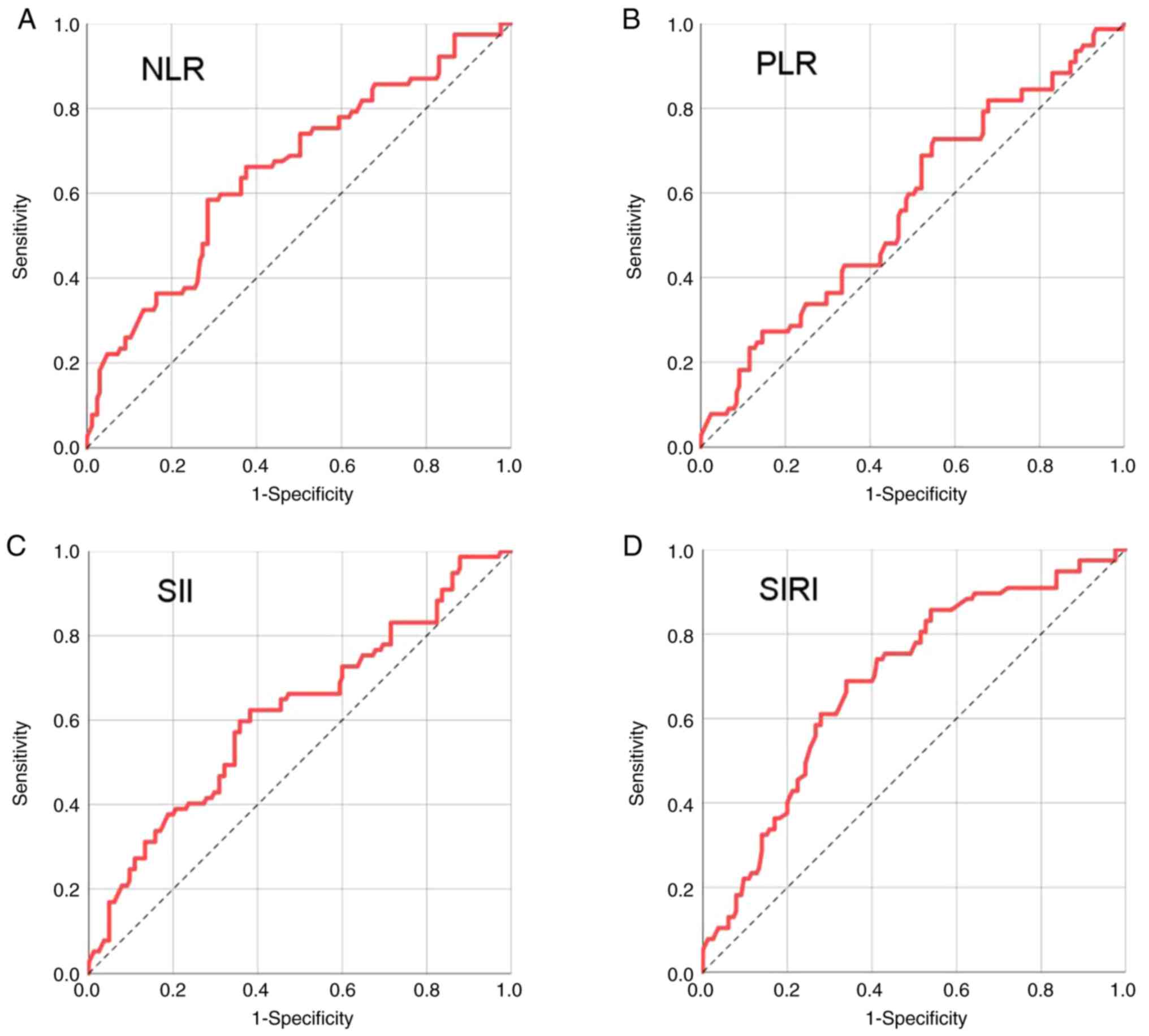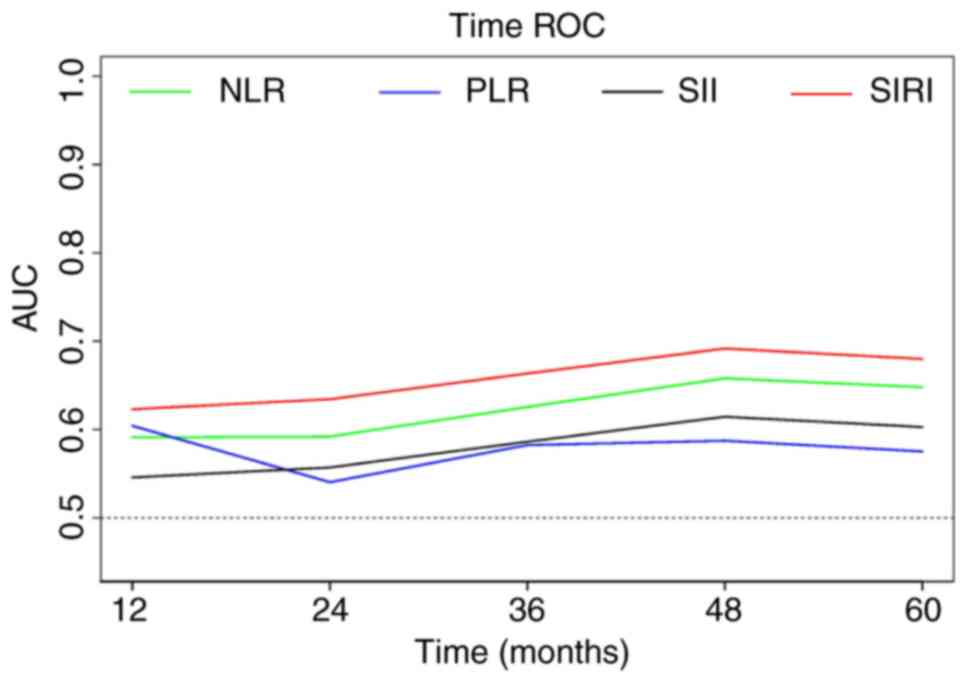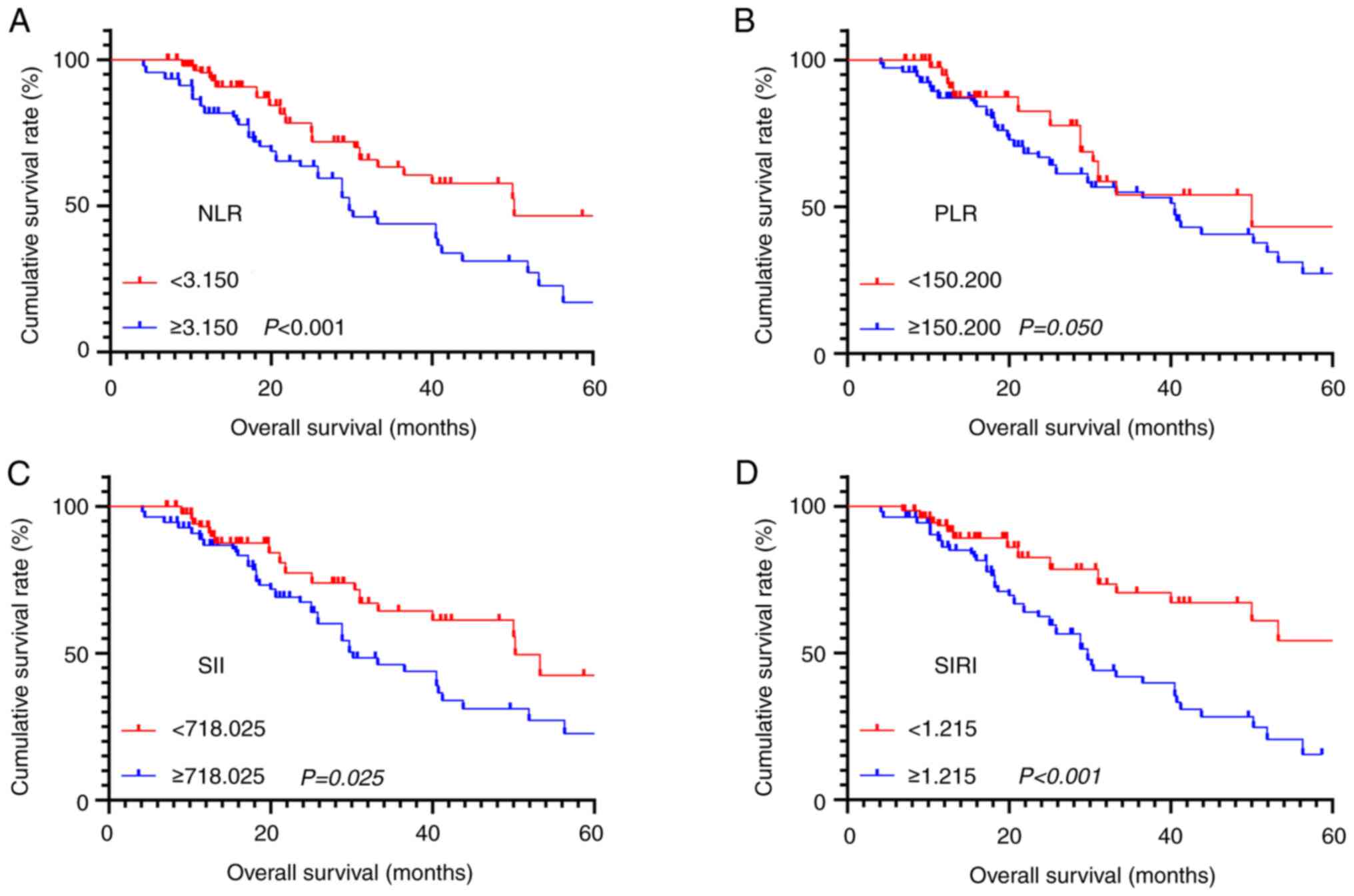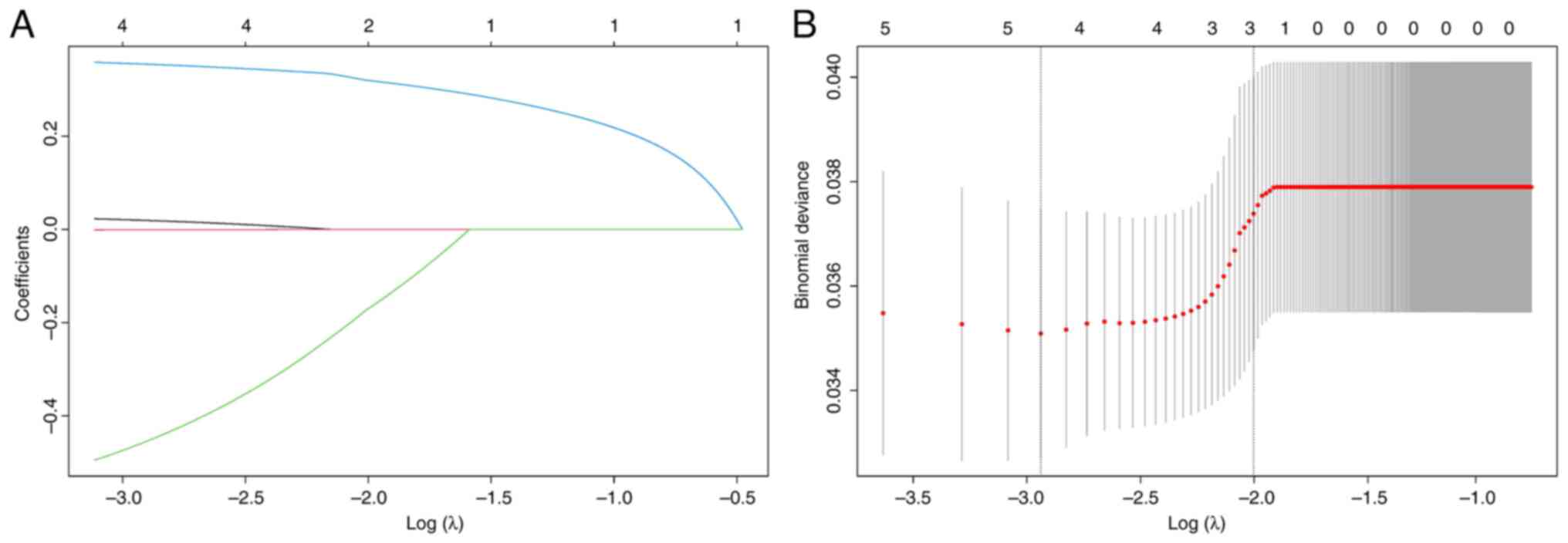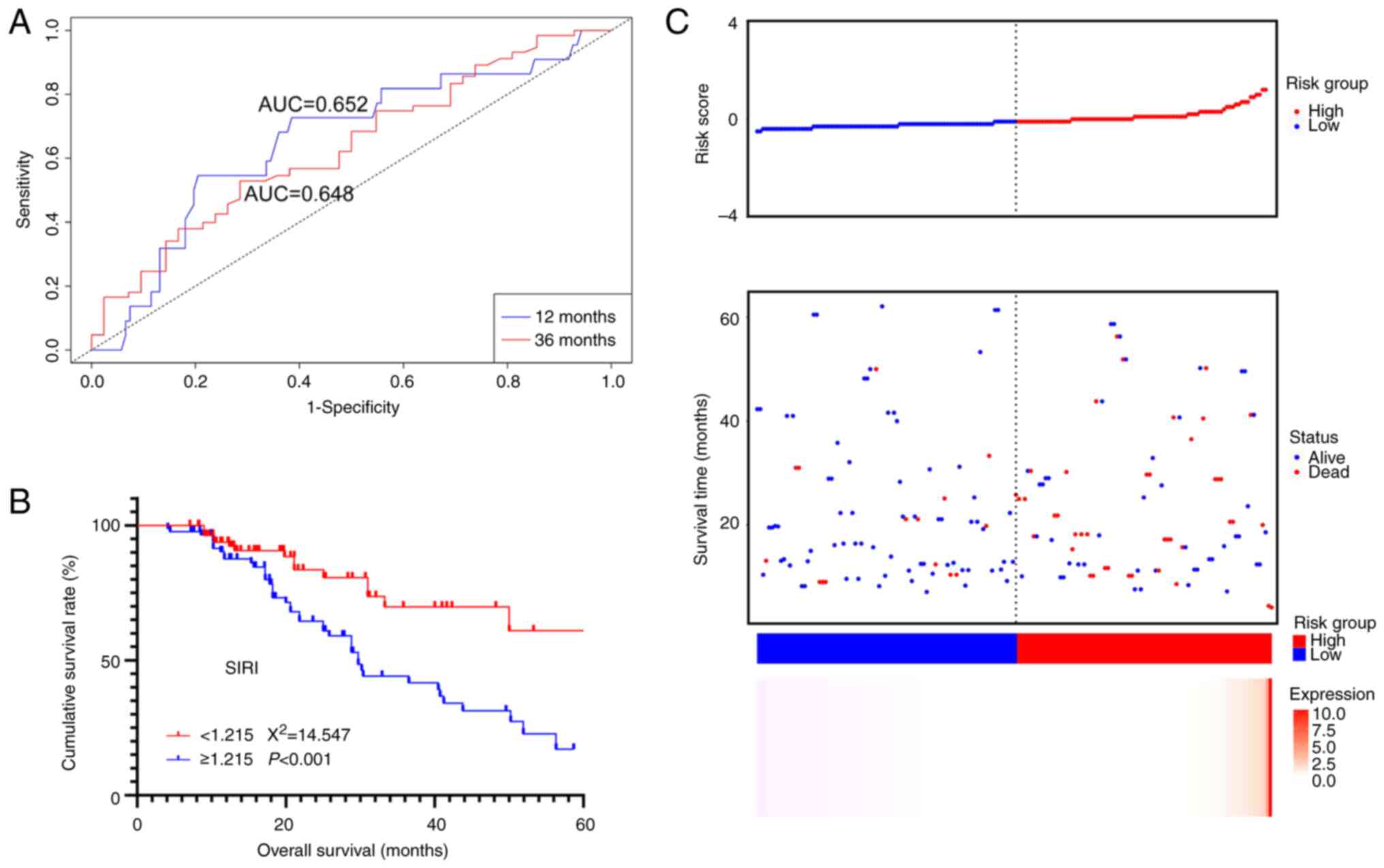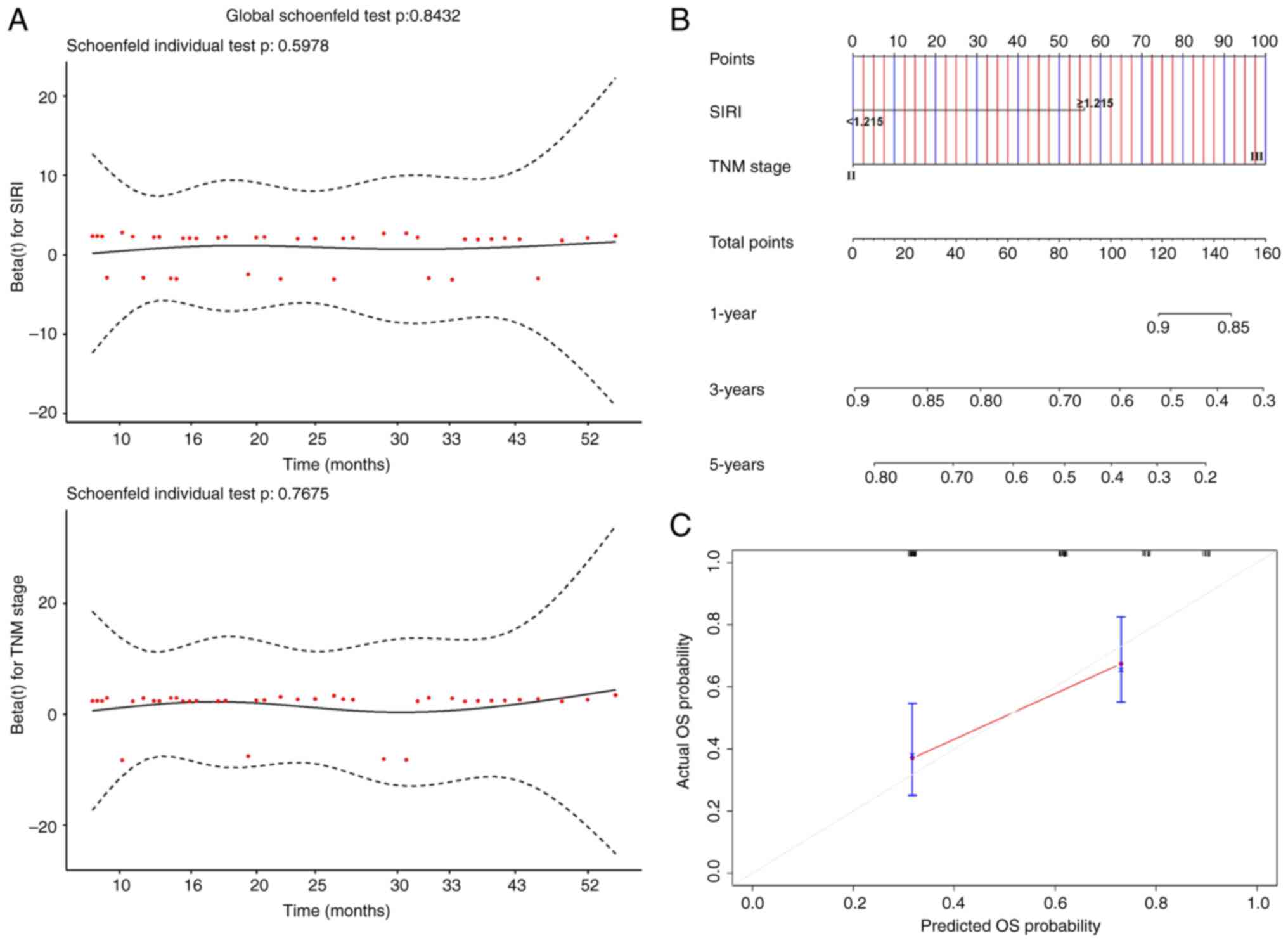Inflammatory status predicts prognosis in patients with gastric cancer with early pyloric stenosis who underwent radical resection: A propensity score‑matching analysis
- Authors:
- Published online on: June 3, 2024 https://doi.org/10.3892/ol.2024.14488
- Article Number: 355
-
Copyright: © He et al. This is an open access article distributed under the terms of Creative Commons Attribution License.
Abstract
Introduction
Gastric cancer, a widespread malignancy on a global scale, imposes a significant burden in terms of both incidence and mortality in numerous countries (1). The prognosis of patients with gastric cancer is influenced by a myriad of factors, including tumor staging, histological type and the overall health status of the individuals (2–4). Due to its high malignancy, investigating the factors influencing the clinical outcomes of gastric cancer remains of significant importance (5,6).
Pyloric stenosis, a relatively common complication, is known to significantly impact the nutritional status of the patients (7,8). It not only disrupts dietary intake and reduces the quality of life but also has a substantial influence on the treatment and prognosis of gastric cancer (9–11). Since pyloric stenosis can lead to decreased treatment tolerance and rapid disease progression, nutritional status has always been a focal point of concern (12–14). While previous studies have primarily examined the nutritional status of pyloric stenosis patients, few have delved into their systemic inflammatory status (15,16). Inflammatory status can impact the disease progression of patients with gastric cancer through various pathways, and a substantial body of previous research has also identified the close relationship and interaction between inflammation and nutritional status (17–19). Therefore, it is still necessary to explore the inflammatory status of patients with gastric cancer with pyloric stenosis and its impact on prognosis.
Hence, the primary objective of the present study was to probe the intricate relationship between systemic inflammatory status and prognosis in patients with gastric cancer who were concurrently afflicted by pyloric stenosis and underwent radical resection, employing a retrospective approach. To mitigate potential biases, propensity score-matching analysis was employed, which enabled the authors to more accurately assess this association. The present study is the first, to the best of the authors' knowledge, to examine the inflammatory status of patients with early pyloric stenosis using multiple classic inflammatory indices and to analyze their impact on patient prognosis. Additionally, the predictive abilities of different inflammatory indices were compared to identify the one with the highest prognostic value.
Patients and methods
Patients
The present retrospective study enrolled 242 patients with gastric cancer at the Affiliated Hospital of Southwest Medical University (Luzhou, China) between July 2016 and December 2020. Inclusion criteria were as follows: i) Patients were confirmed to have early pyloric stenosis. The diagnosis of early pyloric stenosis in patients was established through a comprehensive assessment, including: a) Clinical symptoms: Presentation of upper abdominal pain, bloating, weight loss, acid reflux and fatigue; b) gastroscopic examination: Direct visualization of the stenosis in the pyloric region via gastroscopy, with a biopsy conducted to rule out or confirm malignancy; c) imaging studies: Utilization of upper gastrointestinal barium meal X-ray, CT scan, or MRI to ascertain the location and extent of the stenosis; d) clinical manifestations: Evaluation of the nutritional status of the patient to assess the impact of the stenosis on digestion and absorption. ii) Patients with tumor-node-metastasis (TNM) stage II or III who had received radical resection. iii) Patients who had received complete treatment and follow-up, with comprehensive clinical and medical record data. Exclusion criteria were as follows: i) Patients suffering from chronic inflammatory conditions. A chronic inflammatory condition refers to a prolonged and persistent inflammatory response in the body, which is closely associated with the development, progression and exacerbation of diseases. This state can be induced by various factors, including persistent infections, autoimmune reactions, long-term exposure to harmful substances, chronic stress, or the presence of chronic diseases. It is typically characterized by elevated white blood cell counts, increased levels of inflammatory markers in the blood (such as C-reactive protein, tumor necrosis factor-α and interleukin-6), and infiltration of inflammatory cells in the affected tissues. This condition can lead to tissue damage, fibrosis, impaired organ function, and the onset and progression of chronic diseases. ii) Patients who received preoperative chemotherapy, radiation therapy, or immunotherapy. iii) Patients who were lost to follow-up or had incomplete clinical and pathological information. Since all patients were in TNM stage II and III, they all underwent standard curative resection surgery, and received adjuvant chemotherapy with either the standard SOX (oxaliplatin + S1) or XELOX (oxaliplatin + capecitabine) regimen based on pathological staging 3 weeks postoperatively. This study received approval and support from the Ethics Committee of The Affiliated Hospital of Southwest Medical University (approval no. KY2023224; Luzhou, China).
Data collection and follow-up
Information regarding the general health status and disease progression of patients through the medical record system was screened and collected. To investigate the inflammatory and nutritional status of the patients, pertinent blood parameters, which included total protein, albumin, globulin, prealbumin, neutrophil (NEU), lymphocyte (LYM), monocyte (MON) and platelet counts were concurrently gathered. For preoperative blood collection, 5 ml of fasting venous blood from the elbow was drawn. In total, 2 ml of the blood was transferred into an ethylenediaminetetraacetic acid anticoagulant tube and mixed well, then automatically analyzed for routine hematological parameters using a BC-6000 Automated Hematology Analyzer (Shenzhen Mindray Bio-Medical Electronics Co., Ltd.). Additionally, 3 ml of the blood was transferred into a dry tube and left to stand at room temperature to obtain the upper layer fluid, which was then centrifuged (Sorvall ST8 Benchtop Room Temperature Centrifuge, 20–25 degrees Celsius; Thermo Fisher Scientific, Inc.) at a relative centrifugal force of 3,260 × g for 5 min to separate the serum. The serum biochemical parameters were automatically measured using a cobas® c 311 analyzer (Roche Diagnostics). To investigate systemic inflammation status, neutrophil-to-lymphocyte ratio (NLR), platelet-to-lymphocyte ratio (PLR), systemic immune-inflammation index (SII) and systemic inflammation response index (SIRI) based on the blood parameters of patients were calculated (Table I). The ranges for NLR, PLR, SII and SIRI were 0.77–38.82, 66.27–741.18, 178.89–1,891.76 and 0.24–19.41, respectively. Overall survival (OS) was obtained through routine telephone follow-up and was defined as the period from the first day of surgery to either the date of death or the last follow-up.
Statistical analysis
Categorical variables were described using n (%) and differences were assessed through chi-square test and Fisher's exact test. Continuous variables were presented as mean [standard deviations (SD)] and differences were analyzed using an unpaired Student's t-test. Kaplan-Meier survival curves and log-rank tests were employed to evaluate survival disparities. Cox regression analysis and Lasso regression analysis were utilized to identify independent prognostic factors in the present study and address issues related to multicollinearity. The proportional hazards assumption test was performed using the Cox model and Schoenfeld residual plots. Additionally, to mitigate potential selection bias, propensity score matching (PSM) was employed. Finally, a risk prognosis model and nomogram were constructed to further validate the prognostic value of the inflammatory markers. Two-sided P<0.05 was considered to indicate a statistically significant difference. All statistical analyses were conducted using SPSS 25 (IBM, Corp.) and R 4.1.3 (The R Foundation for Statistical Computing; http://www.r-project.org/).
Results
Patient characteristics
The present study included a total of 242 participants, consisting of 193 male and 49 female patients. The average age of the study cohort was 63.18 (SD, 9.91) years. The age range was 40–81 years. Due to the concurrent presence of pyloric stenosis, most patients exhibited distinct clinical symptoms. Among these patients, 110 (45.5%) experienced stomachache, 128 (52.9%) reported abdominal distention, 105 (43.4%) had weight loss, 94 (38.8%) suffered from sour regurgitation and 61 (25.2%) presented with fatigue. Furthermore, the patients also demonstrated rapid tumor progression, with over half of them having a tumor size of ≥50 mm (55.4%) and being in TNM stage III (66.1%), as shown in Table II.
Inflammatory markers
Receiver operating characteristic (ROC) curves were generated using patient survival status to compare the predictive capabilities of various inflammatory markers and identify their optimal cutoff values (Fig. 1). The optimal cut-off values, determined using the maximum Youden index, were 3.150 for NLR (150 vs. 92 patients), 150.200 for PLR (95 vs. 147 patients), 718.025 for SII (131 vs. 111 patients) and 1.215 for SIRI (133 vs. 109 patients). Their corresponding AUC values were 0.655, 0.569, 0.616 and 0.690, respectively. Notably, SIRI exhibited the highest AUC, demonstrating its strong predictive efficacy (Table III). Furthermore, to further compare their predictive abilities, time-dependent ROC curves were created for the inflammatory markers (Fig. 2). The results revealed that SIRI consistently exhibited the highest AUC at all time points, providing additional confirmation of its excellent predictive performance.
Survival analysis of inflammatory markers
Survival analysis was performed on all inflammatory markers and survival curves were plotted. The results indicated that higher NLR (χ2=10.522, P<0.001), SII (χ2=6.733, P=0.025) and SIRI (χ2=15.490, P<0.001) were all associated with shorter OS, while there was no significant survival difference among patients with different PLR (χ2=2.561, P=0.050) (Fig. 3A-D). In addition, to further explore their prognostic value, univariate and multivariate survival analyses were conducted (Table IV). It was found that neutrophil (P=0.002), monocyte (P=0.023), NLR (P=0.002), SII (P=0.011), SIRI (P<0.001), positive peripheral lymph node (P=0.001) and TNM stage (P<0.001) were associated with the OS of the patients. Given the high correlations among inflammation-related blood parameters and inflammatory markers, Lasso regression analysis was performed on these variables before conducting multivariate analysis to mitigate multicollinearity. After 285 rounds of cross-validation, the optimal λ value was identified as 0.009. Based on the optimal λ value, monocyte and SII were found to be collinear and were excluded from the multivariate analysis (Fig. 4A and B). Finally, SIRI (HR=1.851, P=0.046) and TNM stage (HR=2.906, P=0.033) were identified as independent prognostic factors in this study (Table IV).
Propensity score matching analysis for SIRI
In the present study, SIRI not only exhibited the highest AUC but also proved to be an independent prognostic indicator. To minimize interference factors as much as possible, PSM analysis was conducted on SIRI. Before PSM, there were 133 patients with low SIRI and 109 patients with high SIRI. The chi-square test and Fisher's exact test showed that SIRI was associated with ALB, sex, fatigue, primary tumor site and HER2 expression (all P<0.05). After incorporating all interference factors and setting the matching tolerance to 0.02, a total of 174 patients were successfully matched. After PSM, there were 87 patients in both the low and high SIRI groups, and SIRI was not associated with any clinical or pathological parameter (all P>0.05) (Table V).
The ROC curve and survival curve for SIRI were plotted based on the new dataset. The 1 and 3-year AUC for SIRI were 0.648 and 0.652, respectively, which remained relatively high (Fig. 5A). Additionally, survival analysis indicated that SIRI was still significantly associated with the clinical outcome of the patients, with higher SIRI values associated with lower OS (χ2=14.547, P<0.001, Fig. 5B).
In addition, a prognostic risk model based on SIRI using the β coefficient from the Cox analysis was established. The risk score was calculated as SIRI value ×0.392. The risk factor correlation plot demonstrated a significant association between higher risk scores and lower survival rates (Fig. 5C). This further validated the predictive capacity of SIRI for patient prognosis.
Nomogram for SIRI
A nomogram was constructed to predict patient survival probabilities based on TNM stage and SIRI. Schoenfeld residual plots for TNM stage (P=0.5978) and SIRI (P=0.7675) indicated that neither of them violated the proportional hazards assumption (Fig. 6A). The C-index of the nomogram was 0.671 (Fig. 6B). Furthermore, calibration curves based on bootstrapping also demonstrated a high level of consistency between predicted probabilities and actual probabilities (Fig. 6C). These findings collectively highlighted the high accuracy of the SIRI nomogram.
Discussion
Nutritional status has been demonstrated to be related to the prognosis of various cancers (20–23). A study conducted by Sun et al (24) on the Prognostic Nutritional Index (PNI) in gastric cancer confirmed the association between poor nutritional status and poor survival outcomes. In 2022, they collected data from 146 patients who received postoperative immunotherapy or chemotherapy and found a correlation between low PNI and poor OS. A meta-analysis conducted by Zhang et al (25) in 2023 also reached the same conclusion. Early pyloric stenosis often leads to a poor nutritional status, which significantly impacts the prognosis of patients with gastric cancer. Notably, two retrospective studies conducted between 2021 and 2023 investigated the clinical characteristics and survival outcomes of patients with early pyloric stenosis. Jiao et al (26) and Li et al (27) collected data from 73 and 221 patients, respectively, and found that individuals with early pyloric stenosis not only exhibited poorer nutritional status and tumor burden but also experienced significantly worse survival outcomes compared with patients without early pyloric stenosis. The impact of systemic inflammation on gastric cancer had been a topic of interest for numerous researchers. Hashimoto et al (28) explored the impact of hematologic inflammatory markers on the prognosis of soft tissue sarcomas (STSs). The study included a total of 22 patients with STS treated at their institution and analyzed the correlation between pretreatment blood markers and tumor characteristics. The findings suggested that C-reactive protein levels, white blood cell and neutrophil counts, and NLR may be poor prognostic factors for highly aggressive STSs. Zurlo et al (29) conducted a retrospective analysis of the application of NLR, tumor infiltrating lymphocytes (CD4+/CD8+) and programmed death-ligand 1 expression in patients with gastric cancer who underwent neoadjuvant treatment. Through their analysis of data collected from 65 patients in 2022, they found significant associations between these factors and patient prognosis, indicating that the pre-treatment systemic inflammatory and immune status could influence clinical outcomes. In addition, Wu et al (30) and Qiu et al (31) conducted two meta-analyses that confirmed the significant impact of SII on the prognosis of patients with gastric cancer. These findings indirectly validated the importance of exploring the inflammatory status in patients with pyloric stenosis.
In the present study, the inflammatory status was determined by calculating the NLR, PLR, SII and SIRI of the patient. In the survival analysis of all patients, all inflammatory markers except PLR were significantly associated with OS. In addition, after excluding multicollinearity through Lasso regression analysis, SIRI was also found to be an independent prognostic factor. In addition, SIRI had the highest AUC, indicating its high prognostic value. In further analysis of SIRI, the SIRI after PSM still demonstrated a high AUC and was significantly correlated with OS. The risk prognosis model and nomogram established based on SIRI also revealed high accuracy. This further confirms the significant correlation between inflammatory status and the prognosis of patients with early pyloric stenosis.
The inflammatory status of the patients was reflected through various classic inflammatory indices, including NLR, PLR, SII and SIRI. In the preliminary analysis, it was found that NLR, SII and SIRI were all associated with patient prognosis. Moreover, it was also discovered that SIRI had the highest prognostic value among the inflammatory indices. Therefore, the predictive ability of SIRI for prognosis in detail through PSM was further analyzed and ultimately confirmed its strong predictive power. The specific mechanisms through which inflammatory status affects the clinical outcomes of patients with gastric cancer with early pyloric stenosis remain unclear. Systemic inflammatory status may lead to immune function suppression in patients with gastric cancer (32). This not only weakens the ability of the immune system to inhibit and destroy tumors but also renders patients more susceptible to complications such as infections, thereby accelerating disease progression and reducing treatment effectiveness (33–35). Additionally, some inflammatory mediators can stimulate tumor cell proliferation and promote new blood vessel formation, thus directly contributing to tumor progression (36,37). SIRI consists of NEU, MON and LYM, all of which have been found to be significantly associated with the prognosis of patients with gastric cancer in previous studies (38–41). NEU and MON were demonstrated to play pivotal roles in immune-inflammatory responses, often correlating with the degree of inflammation (42). In certain situations, elevated counts of NEU and MON indicated an overactive immune system or an inflammatory state, which could signal a high tumor burden and potentially exacerbate tumor progression (43,44). Conversely, LYM was revealed as a major component of the antitumor immune response, playing a critical role in resistance against both tumors and infections (45,46). Low counts of LYM indicated immune suppression, which could have led to tumor evasion and dissemination (47). Inflammation status and pyloric stenosis exhibit a close interplay (48). On the one hand, pyloric stenosis directly reduces the energy intake of the patients, leading to malnutrition (49,50). On the other hand, certain inflammatory mediators not only affect the energy intake and absorption of the patients but also induce protein breakdown, decrease muscle mass, result in weight loss, thereby further exacerbating the malnutrition status of the patients (51,52). These factors could all potentially explain why the inflammatory status, particularly SIRI, was closely associated with the clinical outcomes of the patients.
However, the present study was a retrospective study, and despite efforts to minimize selection bias through PSM analysis, there may have been unaccounted-for confounding factors that could have impacted the research results. In addition, the data of this study was only retrieved from one hospital, which might have regional and population specificity, limiting the applicability of the research results. Finally, the optimal cut-off value for inflammatory indicators was calculated through the ROC curve, and there was still no recognized standard. The conclusions of this study require further validation in larger and broader studies. Additionally, while past research on inflammatory indices in other cancers has yielded numerous positive results, the pathogenesis of different cancers varies, as do the factors inducing malnutrition and their impact on tumors. Therefore, the applicability of the findings of the present study to other cancers still requires confirmation through further research involving larger sample sizes and multiple types of cancer.
In conclusion, inflammatory status was significantly associated with the prognosis of patients with gastric cancer with early pyloric stenosis who underwent radical resection. The NLR, SII and SIRI could all predict patient outcomes. Moreover, SIRI exhibited the highest prognostic value among the inflammatory indices and has been identified as an independent prognostic factor in the present study.
Acknowledgements
Not applicable.
Funding
Funding: No funding was received.
Availability of data and materials
The data generated in the present study may be requested from the corresponding author.
Authors' contributions
The design and writing of the original manuscript draft was conducted by LH. Data acquisition was performed by JL. XL and XW conducted the analysis and interpretation of data. QY contributed to the allocation of resources, conception, design and project administration. All authors read and approved the final version of the manuscript. LH and QY confirm the authenticity of all the raw data.
Ethics approval and consent to participate
The present study was approved by the Ethics Committee of the Affiliated Hospital of Southwest Medical University (approval no. KY2023224; Luzhou, China). The Ethics Committee of the Affiliated Hospital of Southwest Medical University has waived the need for patient informed consent due to the retrospective nature of the study.
Patient consent for publication
Not applicable.
Competing interests
The authors declare that they have no competing interests.
References
|
López MJ, Carbajal J, Alfaro AL, Saravia LG, Zanabria D, Araujo JM, Quispe L, Zevallos A, Buleje JL, Cho CE, et al: Characteristics of gastric cancer around the world. Crit Rev Oncol Hematol. 181:1038412023. View Article : Google Scholar : PubMed/NCBI | |
|
Japanese Gastric Cancer Association, . Japanese gastric cancer treatment guidelines 2021 (6th edition). Gastric Cancer. 26:1–25. 2023. View Article : Google Scholar : PubMed/NCBI | |
|
Guan WL, He Y and Xu RH: Gastric cancer treatment: Recent progress and future perspectives. J Hematol Oncol. 16:572023. View Article : Google Scholar : PubMed/NCBI | |
|
Smyth EC, Nilsson M, Grabsch HI, van Grieken NC and Lordick F: Gastric cancer. Lancet. 396:635–648. 2020. View Article : Google Scholar : PubMed/NCBI | |
|
Röcken C: Predictive biomarkers in gastric cancer. J Cancer Res Clin Oncol. 149:467–481. 2023. View Article : Google Scholar : PubMed/NCBI | |
|
Tan Z: Recent advances in the surgical treatment of advanced gastric cancer: A review. Med Sci Monit. 25:3537–3541. 2019. View Article : Google Scholar : PubMed/NCBI | |
|
Tanaka Y, Fujii S, Kusaka T and Kokuryu H: Gastric mucosal carcinoma with pyloric stenosis. Internal Med. 60:807–808. 2021. View Article : Google Scholar : PubMed/NCBI | |
|
Iwai N, Okuda T and Kagawa K: Gastrointestinal: Natural progression of early gastric cancer causing pyloric stenosis. J Gastroenterol Hepatol. 35:92020. View Article : Google Scholar : PubMed/NCBI | |
|
Shimura T, Kataoka H, Sasaki M, Yamada T, Hayashi K, Togawa S, Okumura F, Kubota E, Ohara H and Joh T: Feasibility of self-expandable metallic stent plus chemotherapy for metastatic gastric cancer with pyloric stenosis. J Gastroenterol Hepatol. 24:1358–1364. 2009. View Article : Google Scholar : PubMed/NCBI | |
|
Abe S, Kondo H, Sumiyoshi T, Mizushima T, Sugawara M, Shimizu Y and Okushiba S: Treatment strategy for early gastric cancer with the risk of pyloric stenosis after endoscopic resection. Endoscopy. 41:1101–1103. 2009. View Article : Google Scholar : PubMed/NCBI | |
|
Lee JU, Park MS, Yun SH, Yang MA, Han SH, Lee YJ, Jung GM, Kim JW, Cho YK and Cho JW: Risk factors and management for pyloric stenosis occurred after endoscopic submucosal dissection adjacent to pylorus. Medicine (Baltimore). 95:e56332016. View Article : Google Scholar : PubMed/NCBI | |
|
Acker SN, Kulungowski AM, Hodges M, Crombleholme TM, Somme S and Partrick DA: Pyloric stenosis-postoperative care on a nonsurgical ward. J Surg Res. 199:149–152. 2015. View Article : Google Scholar : PubMed/NCBI | |
|
Trindade AJ, Sejpal DV and Benias PC: Palliation of malignant pyloric stenosis using a lumen-apposing metal stent. Clin Gastroenterol Hepatol. 17:A182019. View Article : Google Scholar : PubMed/NCBI | |
|
Saeed SM, Bilal S, Siddique MZ, Saqib M, Shahid S, Ghumman AN and Yusuf MA: Pyloric stent insertion in malignant gastric outlet obstruction: Moving beyond palliation. Ther Adv Gastrointest Endosc. 14:263177452110470122021.PubMed/NCBI | |
|
Jomrich G, Paireder M, Kristo I, Baierl A, Ilhan-Mutlu A, Preusser M, Asari R and Schoppmann SF: High systemic immune-inflammation index is an adverse prognostic factor for patients with gastroesophageal adenocarcinoma. Ann Surg. 273:532–541. 2021. View Article : Google Scholar : PubMed/NCBI | |
|
Shi H, Wang H, Pan J, Liu Z and Li Z: Comparing prognostic value of preoperative platelet indexes in patients with resectable gastric cancer. Sci Rep. 12:64802022. View Article : Google Scholar : PubMed/NCBI | |
|
Liu YY, Ruan GT, Ge YZ, Li QQ, Zhang Q, Zhang X, Tang M, Song MM, Zhang XW, Li XR, et al: Systemic inflammation with sarcopenia predicts survival in patients with gastric cancer. J Cancer Res Clin. 149:1249–1259. 2023. View Article : Google Scholar : PubMed/NCBI | |
|
He K, Si L, Pan X, Sun L, Wang Y, Lu J and Wang X: Preoperative systemic immune-inflammation index (SII) as a superior predictor of long-term survival outcome in patients with stage I–II gastric cancer after radical surgery. Front Oncol. 12:8296892022. View Article : Google Scholar : PubMed/NCBI | |
|
Ding P, Guo H, Sun C, Yang P, Kim NH, Tian Y, Liu Y, Liu P, Li Y and Zhao Q: Combined systemic immune-inflammatory index (SII) and prognostic nutritional index (PNI) predicts chemotherapy response and prognosis in locally advanced gastric cancer patients receiving neoadjuvant chemotherapy with PD-1 antibody sintilimab and XELOX: A prospective study. BMC Gastroenterol. 22:1212022. View Article : Google Scholar : PubMed/NCBI | |
|
Li P, Huang CM, Zheng CH, Russo A, Kasbekar P, Brennan MF, Coit DG and Strong VE: Comparison of gastric cancer survival after R0 resection in the US and China. J Surg Oncol. 118:975–982. 2018. View Article : Google Scholar : PubMed/NCBI | |
|
Meng Q, Tan S, Jiang Y, Han J, Xi Q, Zhuang Q and Wu G: Post-discharge oral nutritional supplements with dietary advice in patients at nutritional risk after surgery for gastric cancer: A randomized clinical trial. Clin Nutr. 40:40–46. 2021. View Article : Google Scholar : PubMed/NCBI | |
|
Miao X, Ding L, Hu J, Zhu H, Zhao K, Lu J, Jiang X, Xu Q and Zhu S: A web-based calculator combining geriatric nutritional risk index (GNRI) and tilburg frailty indicator (TFI) predicts postoperative complications among young elderly patients with gastric cancer. Geriatr Gerontol Int. 23:205–212. 2023. View Article : Google Scholar : PubMed/NCBI | |
|
Ruan GT, Zhang Q, Zhang X, Tang M, Song MM, Zhang XW, Li XR, Zhang KP, Ge YZ, Yang M, et al: Geriatric nutrition risk index: Prognostic factor related to inflammation in elderly patients with cancer cachexia. J Cachexia Sarcopenia Muscle. 12:1969–1982. 2021. View Article : Google Scholar : PubMed/NCBI | |
|
Sun H, Chen L, Huang R, Pan H, Zuo Y, Zhao R, Xue Y and Song H: Prognostic nutritional index for predicting the clinical outcomes of patients with gastric cancer who received immune checkpoint inhibitors. Front Nutr. 9:10381182022. View Article : Google Scholar : PubMed/NCBI | |
|
Zhang L, Ma W, Qiu Z, Kuang T, Wang K, Hu B and Wang W: Prognostic nutritional index as a prognostic biomarker for gastrointestinal cancer patients treated with immune checkpoint inhibitors. Front Immunol. 14:12199292023. View Article : Google Scholar : PubMed/NCBI | |
|
Jiao X, Wang Y, Qu X, Qu J and Wang X: Effects of preoperative pyloric stenosis on outcomes and nutritional status in 73 patients following curative gastrectomy for gastric cancer: A retrospective study from a single center. Med Sci Monit. 27:e9309742021. View Article : Google Scholar : PubMed/NCBI | |
|
Li G, He L and Sun H: Nutritional risk index predicts the prognosis of gastric cancer patients with pyloric stenosis who received preoperative parenteral nutrition. Oncol Lett. 26:4012023. View Article : Google Scholar : PubMed/NCBI | |
|
Hashimoto K, Nishimura S, Shinyashiki Y, Ito T and Akagi M: Characterizing inflammatory markers in highly aggressive soft tissue sarcomas. Medicine (Baltimore). 101:e306882022. View Article : Google Scholar : PubMed/NCBI | |
|
Zurlo IV, Schino M, Strippoli A, Calegari MA, Cocomazzi A, Cassano A, Pozzo C, Di Salvatore M, Ricci R, Barone C, et al: Predictive value of NLR, TILs (CD4+/CD8+) and PD-L1 expression for prognosis and response to preoperative chemotherapy in gastric cancer. Cancer Immunol Immunother. 71:45–55. 2022. View Article : Google Scholar : PubMed/NCBI | |
|
Wu J, Wu XD and Gao Y and Gao Y: Correlation between preoperative systemic immune-inflammatory indexes and the prognosis of gastric cancer patients. Eur Rev Med Pharmacol Sci. 27:5706–5720. 2023.PubMed/NCBI | |
|
Qiu Y, Zhang Z and Chen Y: Prognostic value of pretreatment systemic immune-inflammation index in gastric cancer: A meta-analysis. Front Oncol. 11:5371402021. View Article : Google Scholar : PubMed/NCBI | |
|
Venet F and Monneret G: Advances in the understanding and treatment of sepsis-induced immunosuppression. Nat Rev Nephrol. 14:121–137. 2018. View Article : Google Scholar : PubMed/NCBI | |
|
Xia L, Oyang L, Lin J, Tan S, Han Y, Wu N, Yi P, Tang L, Pan Q, Rao S, et al: The cancer metabolic reprogramming and immune response. Mol Cancer. 20:282021. View Article : Google Scholar : PubMed/NCBI | |
|
Chen DS and Mellman I: Elements of cancer immunity and the cancer-immune set point. Nature. 541:321–330. 2017. View Article : Google Scholar : PubMed/NCBI | |
|
van Weverwijk A and de Visser KE: Mechanisms driving the immunoregulatory function of cancer cells. Nat Rev Cancer. 23:193–215. 2023. View Article : Google Scholar : PubMed/NCBI | |
|
Andrejeva G and Rathmell JC: Similarities and distinctions of cancer and immune metabolism in inflammation and tumors. Cell Metab. 26:49–70. 2017. View Article : Google Scholar : PubMed/NCBI | |
|
Vinay DS, Ryan EP, Pawelec G, Talib WH, Stagg J, Elkord E, Lichtor T, Decker WK, Whelan RL, Kumara HMCS, et al: Immune evasion in cancer: Mechanistic basis and therapeutic strategies. Semin Cancer Biol. 35 (Suppl 35):S185–S198. 2015. View Article : Google Scholar : PubMed/NCBI | |
|
Fang T, Wang Y, Yin X, Zhai Z, Zhang Y, Yang Y, You Q, Li Z, Ma Y, Li C, et al: Diagnostic sensitivity of NLR and PLR in early diagnosis of gastric cancer. J Immunol Res. 2020:91460422020. View Article : Google Scholar : PubMed/NCBI | |
|
Cupp MA, Cariolou M, Tzoulaki I, Aune D, Evangelou E and Berlanga-Taylor AJ: Neutrophil to lymphocyte ratio and cancer prognosis: An umbrella review of systematic reviews and meta-analyses of observational studies. BMC Med. 18:3602020. View Article : Google Scholar : PubMed/NCBI | |
|
Hirahara T, Arigami T, Yanagita S, Matsushita D, Uchikado Y, Kita Y, Mori S, Sasaki K, Omoto I, Kurahara H, et al: Combined neutrophil-lymphocyte ratio and platelet-lymphocyte ratio predicts chemotherapy response and prognosis in patients with advanced gastric cancer. BMC Cancer. 19:6722019. View Article : Google Scholar : PubMed/NCBI | |
|
Ye Z, Yu P, Cao Y, Chai T, Huang S, Cheng X and Du Y: Prediction of Peritoneal cancer index and prognosis in peritoneal metastasis of gastric cancer using NLR-PLR-DDI score: A retrospective study. Cancer Manag Res. 14:177–187. 2022. View Article : Google Scholar : PubMed/NCBI | |
|
Ikegame A, Kondo A, Kitaguchi K, Sasa K and Miyoshi M: Presepsin production in monocyte/macrophage-mediated phagocytosis of neutrophil extracellular traps. Sci Rep. 12:59782022. View Article : Google Scholar : PubMed/NCBI | |
|
Fendl B, Berghoff AS, Preusser M and Maier B: Macrophage and monocyte subsets as new therapeutic targets in cancer immunotherapy. ESMO Open. 8:1007762023. View Article : Google Scholar : PubMed/NCBI | |
|
Que H, Fu Q, Lan T, Tian X and Wei X: Tumor-associated neutrophils and neutrophil-targeted cancer therapies. Biochim Biophys Acta Rev Cancer. 1877:1887622022. View Article : Google Scholar : PubMed/NCBI | |
|
MacPherson S, Kilgour M and Lum JJ: Understanding lymphocyte metabolism for use in cancer immunotherapy. FEBS J. 285:2567–2578. 2018. View Article : Google Scholar : PubMed/NCBI | |
|
Pan JH, Zhou H, Cooper L, Huang JL, Zhu SB, Zhao XX, Ding H, Pan YL and Rong L: LAYN is a prognostic biomarker and correlated with immune infiltrates in gastric and colon cancers. Front Immunol. 10:62019. View Article : Google Scholar : PubMed/NCBI | |
|
Wang Q, Li S, Qiao S, Zheng Z, Duan X and Zhu X: Changes in T lymphocyte subsets in different tumors before and after radiotherapy: A meta-analysis. Front Immunol. 12:6486522021. View Article : Google Scholar : PubMed/NCBI | |
|
Soldati L, Di Renzo L, Jirillo E, Ascierto PA, Marincola FM and De Lorenzo A: The influence of diet on anti-cancer immune responsiveness. J Transl Med. 16:752018. View Article : Google Scholar : PubMed/NCBI | |
|
Matsunaga T, Miyata H, Sugimura K, Motoori M, Asukai K, Yanagimoto Y, Takahashi Y, Tomokuni A, Yamamoto K, Akita H, et al: Prognostic significance of sarcopenia and systemic inflammatory response in patients with esophageal cancer. Anticancer Res. 39:449–458. 2019. View Article : Google Scholar : PubMed/NCBI | |
|
Liu Z, Jin K, Guo M, Long J, Liu L, Liu C, Xu J, Ni Q, Luo G and Yu X: Prognostic value of the CRP/Alb ratio, a novel inflammation-based score in pancreatic cancer. Ann Surg Oncol. 24:561–568. 2017. View Article : Google Scholar : PubMed/NCBI | |
|
Liu JX, Li A, Zhou LY, Liu XF, Wei ZH, Wang XZ and Ying HQ: Significance of combined preoperative serum Alb and dNLR for diagnosis of pancreatic cancer. Future Oncol. 14:229–239. 2018. View Article : Google Scholar : PubMed/NCBI | |
|
Stumpf F, Keller B, Gressies C and Schuetz P: Inflammation and nutrition: Friend or foe? Nutrients. 15:11592023. View Article : Google Scholar : PubMed/NCBI |



